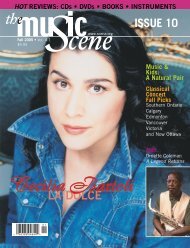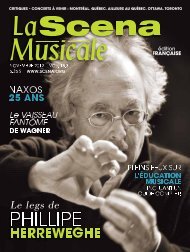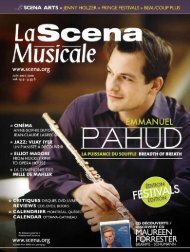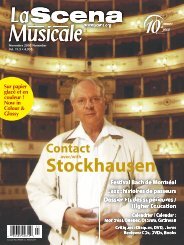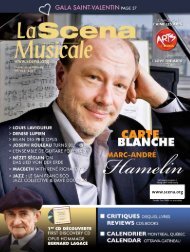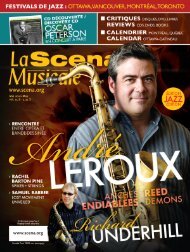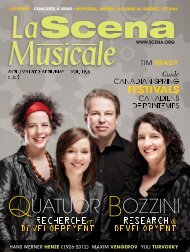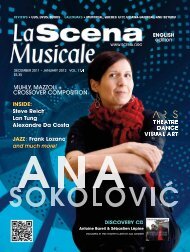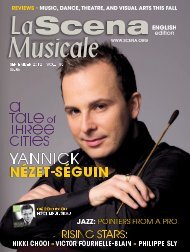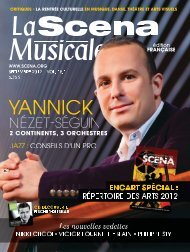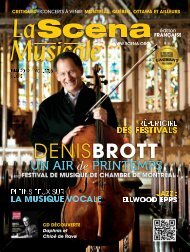You also want an ePaper? Increase the reach of your titles
YUMPU automatically turns print PDFs into web optimized ePapers that Google loves.
GILLES<br />
TREMBLAY<br />
Lucie Renaud<br />
Some say the fairytale opera L’eau qui<br />
danse, la pomme qui chante et l’oiseau<br />
qui dit la vérité will be the height of<br />
Gilles Tremblay’s creative output.<br />
Pauline Vaillancourt, an orchestra conductor<br />
and artistic director of Chants libres, is<br />
well acquainted with the composer’s work; she<br />
has been involved in productions of Oralléluiants,<br />
DZEÏ Voies de feu, and Vêpres de la Vierge. She<br />
remembers Vêpres as one of the most significant<br />
experiences in her career. From as early as 1995,<br />
she was determined to convince Tremblay to<br />
write an opera. In 2002, the opera was commissioned.<br />
Thus began the lengthy journey leading<br />
up to the premiere of this two hour-long lyric<br />
work on November 19.<br />
Permeated by a strong poetic strain, L’eau qui<br />
danse, la pomme qui chante et l’oiseau qui dit la<br />
vérité is the product of a collaboration between<br />
Tremblay and poet/novelist Pierre Morency (signing<br />
his debut libretto), two men united by a<br />
shared affinity with nature.“They speak the same<br />
language,” explained Pauline Vaillancourt. Pierre<br />
Morency, for his part, described the collaboration<br />
as a “very special meeting, a coming together<br />
that made the birth of this work possible.” The<br />
partners’ first step was to research the folklore<br />
archives of <strong>La</strong>val University to trace the original<br />
tale that had inspired Madame D’Aulnoy and<br />
seduced Tremblay. Before proposing a first draft<br />
that would impart their common vision, Morency<br />
dedicated himself to an in-depth study of several<br />
operas, giving particular attention to the libretti.<br />
Innumerable discussions ensued: on the characteristics<br />
of the plot’s heroes, and even on every<br />
line of the lyrics. This all enabled the writer to<br />
refine his rereading of the original tale. “Every<br />
word was re-examined, discussed, and made to<br />
conform with the music it would support,”<br />
explained Morency. “A libretto not only tells a<br />
story, but provides a base from which the composer<br />
can launch into his music.”<br />
The work eventually took concrete form in July<br />
2008 with a sight-reading accompanied by piano.<br />
During the following year, the final choices for the<br />
cast were made and the copyist undertook the<br />
arduous task of producing separate scores for the 12<br />
singers (including actor-singer Jean Maheu) and 26<br />
instrumentalists (eight violins, one cello, three double<br />
basses, woodwinds, three percussion instruments,<br />
and piano). On September 3, 2009, the whole<br />
FROM DREAM to REALITY<br />
PAULINE VAILLANCOURT (DIRECTRICE DE CHANTS LIBRES), ROBERT<br />
BELLEFEUILLE (METTEURE EN SCÈNE), PIERRE MORENCY (LIVRET) ET JEAN<br />
BARD (SCÉNOGRAPHIE)<br />
team met for an introductory overview and runthrough.<br />
Pierre Morency describes the experience as<br />
three hours of wonderment: “After hearing the<br />
work, I was suffused with it for days. I would wish<br />
this kind of revelation for everyone.” He also recalls<br />
how Tremblay was astounded by the professionalism<br />
of the performers; everyone was already<br />
steeped in his or her role.“Everyone is adding a little<br />
pebble, but the result will be a magnificent edifice,”<br />
confidently affirmed Vaillancourt, who last recorded<br />
Tremblay’s monodrama À quelle heure commence le<br />
temps? with the Nouvel Ensemble Musical in 2005.<br />
“From their very first contact with the opera, the<br />
singers and musicians adored the work. Each character<br />
has its own colour, rhythm, and tone; it’s simply<br />
a question of transmitting them.”<br />
Hundreds of hours of rehearsal were scheduled<br />
in the prelude to the first public performance.<br />
The greatest musical challenge remaining<br />
is to succeed in conveying the coherence of the<br />
work and extracting different layers from it,<br />
whether these are the unaccompanied solos with<br />
their rhythmic prosody, or the director’s appropriation<br />
of the textures, shades, and details (which<br />
are never gratuitous) integrated by Tremblay into<br />
moments of “disciplined freedom.”<br />
Every creation has its unique palette, and it is<br />
essential to find a theatrical director who can<br />
understand the unity between the music and the<br />
acting. Impressed by Robert de Bellefeuille’s<br />
directing for <strong>La</strong> dame aux camélias, Vaillancourt<br />
proposed that he be in charge of the theatrical<br />
direction of the opera. De Bellefeuille admits to<br />
having felt an inner vertigo when considering<br />
this new challenge. Before accepting, he wanted<br />
MANUEL CODINA, GASPACHO FILMS<br />
to meet with the composer to better<br />
understand the work’s genesis.<br />
He said of Tremblay: “The man<br />
vibrates, he’s a veritable river of<br />
words. I already saw myself becoming<br />
the master’s apprentice. I<br />
explained to him I would take what<br />
he had imagined and merge my<br />
sensitivity with it. I delved into the<br />
text, into the words, working like an<br />
archaeologist. It was essential to<br />
give centre stage to the music and<br />
the story, to cross the frontier<br />
between dream and reality.”<br />
Initially leaving the score aside, de<br />
Bellefeuille began by working with<br />
the singers on the relationships<br />
among the characters, analyzing the<br />
text with them to capture the most intricate subtleties<br />
of the narrative thread:“I may be the captain,<br />
but we’re all on the same ship and we’ve got to tell<br />
the same story.” Jean Bard’s set design and Nicolas<br />
Descoteaux’s lighting, both inspired by imagery of<br />
the Northern Lights, were quite naturally drafted. In<br />
de Bellefeuille’s view: “What we see derives from<br />
what we hear; we have to determine the share of<br />
the music, the words, the visual aspect, and never<br />
look without listening. We must hear the visual<br />
component and see the music, feel the opposition<br />
between consonance and dissonance. The music is<br />
very evocative emotionally and so full of new<br />
departures that it was imperative to lean on the<br />
side of purity, to provide a receptacle for the music.”<br />
Morency added: “This requires daring, courage,<br />
both in the music and in the possibility of the audience<br />
being able to appreciate a work like this.”<br />
As occurs all too often, a cruel twist of fate<br />
intervened, and Tremblay could not be present at<br />
the rehearsals: he is convalescing from a CVA.<br />
Fired up with enthusiasm, de Bellefeuille concluded:<br />
“We have the very delicate responsibility<br />
of bringing this work into the world. It traverses<br />
our whole bodies; we are investing a part of ourselves<br />
in it, unreservedly, uncompromisingly. The<br />
work will only be complete on the evening of the<br />
premiere; it is up to us to bring it forward without<br />
imposing it, in such a way that the audience will<br />
embrace it and be transported by it.” ■<br />
[Translation: Darcy Dunton]<br />
Monument National, November 19, 20, and 21, 2009.<br />
The production will be broadcast by Radio-Canada<br />
(Espace musique) on December 5, 2009, at 1:00 p.m.<br />
Novembre 2009 November 21



